The regional conservation agenda calls for substantial and sustained investment to save lands and waters. Meanwhile, the Finger Lakes Land Trust is already working with partners across the region – see our recent success stories on this page.
Protect Our Lakes, Streams, and Drinking Water
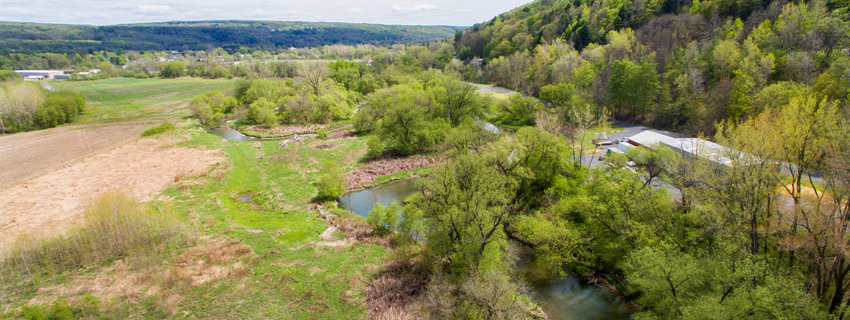
Photo: Bill Hecht
Buffer Our Streams and Create New Wetlands
Success Story: Owasco Flats
In partnership with the NYS Department of Environmental Conservation and the US Fish and Wildlife Service (USFWS), the Finger Lakes Land Trust acquired and restored a key property bordering the Owasco Inlet – the largest tributary to Owasco Lake. The property had been identified as a priority for protection because it included 2,300 feet of eroding streambank. Every spring, flood waters carried nitrogen and phosphorous-laden soil into the lake from a streamside corn field, feeding algae blooms in the lake. The Land Trust acquired the 15-acre property and then partnered with the USFWS to restore wetland and streamside habitat – planting trees and shrubs along the streambanks to hold soil and decrease erosion.
The Land Trust recently donated the property to New York State as an addition to the Owasco Flats Wildlife Management Area. Today, the public can use this site for outdoor recreation, including wildlife observation, fishing, and hunting.

Photo: Bill Hecht
Save Our Last Undeveloped Shoreline Now
Success Story: Otisco Lake
The Finger Lakes Land Trust moved quickly in early 2016 to purchase a rare stretch of undeveloped shoreline on Otisco Lake, the easternmost Finger Lake. The 38-acre hillside property features 1,300 feet of wild lakeshore with a small point and lakeside cliffs. Protecting this land will ensure habitat for Bald Eagles and migratory water birds, help protect a public drinking water supply, and provide seasonal public access to the shore. The Land Trust intends to open the site to the public sometime during 2017, once the organization has built a modest parking area and created a hiking trail to the shore.
Thanks to a lead gift from an anonymous donor and subsequent gifts from local residents, the Land Trust was able to secure this magnificent stretch of shoreline. Fundraising is still underway to provide for the long-term management of the land.
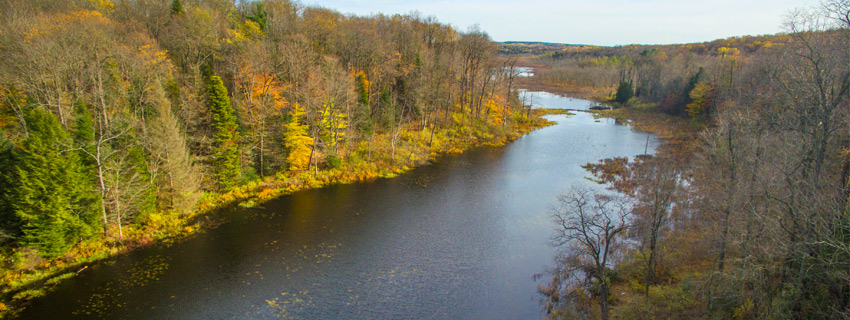
Photo: Bill Hecht
Protect the City of Syracuse Drinking Water Supply
Success Story: Bear Swamp Creek Conservation Easement
Landowners David and Francie Pringle donated a conservation easement on their 200-acre property, partnering with the Land Trust to protect nearly a mile of frontage on Bear Swamp Creek – the largest tributary to Skaneateles Lake. Conservation easements are perpetual legal agreement that limit future development, but keep land in private ownership. The Pringle’s easement agreement provides buffer areas along the creek while accommodating traditional agricultural and forestry use in other areas. Although the Pringles received some tax benefits for donating the easement, their primary motive was to ensure the future of their property, which borders other protected lands and is part of a growing conservation corridor along Bear Swamp Creek.
Unfortunately, many landowners are unable to donate a conservation easement due to their financial position. In a program that ended in 2012, the City of Syracuse proactively purchased conservation easements on more than 800 acres of land to help protect Skaneateles Lake’s water quality. With development pressure increasing in the Skaneateles area, it’s time to resume this program to ensure the future of this sparkling lake.
Save Farms, Wineries, and Rural Character
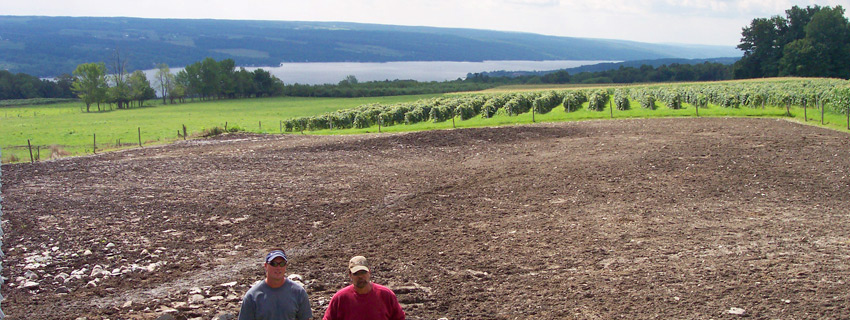
Photo: Staff
Save Threatened Farms and Wineries
Success Story: Gillette Farm Easement, Yates County
Curtis and Susan Gillette’s fourth generation farm has amazing views of Keuka Lake, which is less than a mile away. Because of these views, they’ve been approached in the past with development purchase offers. Thanks to funding from New York State’s Department of Agriculture & Markets, and a partnership between the Finger Lakes Land Trust and Yates County, the Gillettes were able to sell a conservation easement to prevent their farm from being developed. Funds gained from the sale helped them grow their farm operation.
The Gillette farm is one of four Yates County farms protected through this partnership. Unfortunately, state funding has been limited and demand for the program is high. In Yates County alone, there are nine farmers who are ready to commit to the protection of their lands – all of which are located in identified focus areas. One of these farmers has been on the county’s waiting list since 2006.
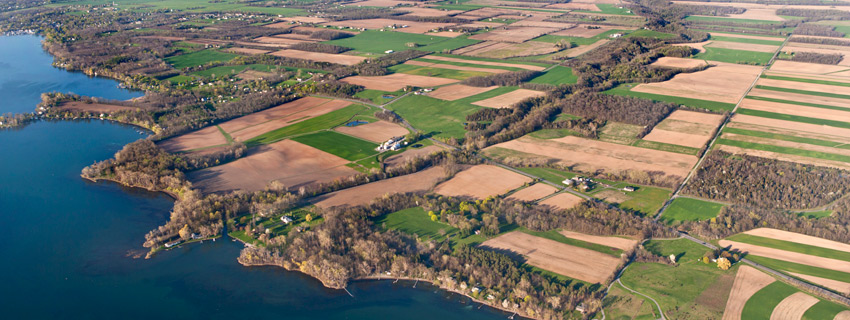
Protect Scenic Vistas and Designated Scenic Byways on Cayuga and Seneca Lakes
Success Story: Cayuga Lake Scenic Byway – Great Gully Farm Easement
Great Gully Farm is truly one of a kind. Located between the communities of Aurora and Union Springs, the farm is known to many Cayuga Lake Scenic Byway travelers. The byway bisects the 600-acre farm, which features more than 3,000 feet of lakeshore, fields, and part of a rugged gorge known for its waterfalls. Thanks to the generosity of the McIntosh family, Great Gully is now protected by a conservation easement that is held by the Finger Lakes Land Trust. The easement allows continued agricultural use but also has special environmental protection zones along the lakeshore and next to the gully for which the farm is named.
While the future of Great Gully Farm is now secure, this is not the case for other vistas along our scenic byways. With each passing year, we’re gradually losing scenic views to incremental development. To ensure that our state highways and byways retain their scenic character, we must first assess and prioritize scenic vistas and then take action to protect these views through the use of conservation easements that allow the land to remain in private ownership.
Keep Nature Wild and Enhance Public Access
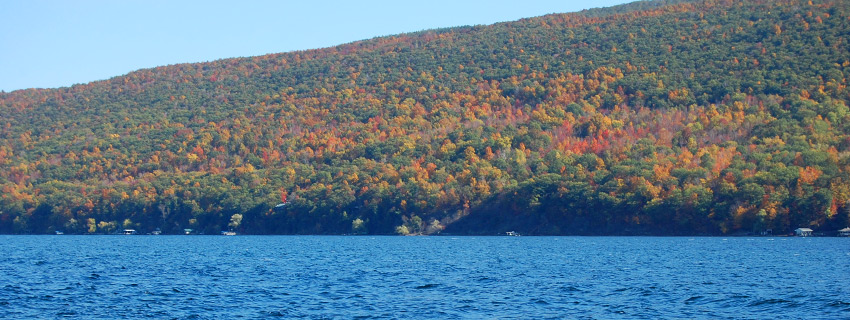
Photo: FLLT
Create the Canandaigua Skyline Trail
Success Story: Creating a Corridor of Conserved Land on Bare Hill
Thanks to a partnership between the Finger Lakes Land Trust and the NYS Department of Environmental Conservation, a continuous corridor of conserved land now runs from the eastern shore of Canandaigua Lake to the summit of Bare Hill – an iconic landmark known for its significance in the creation stories of the Seneca Nation.
Over the past decade, the Land Trust has acquired five parcels on Bare Hill from willing sellers. If the Land Trust had not been in a position to move quickly to acquire these lands, they would have likely been sold for residential development. By adding to existing public land at Bare Hill, these projects enhance opportunities for outdoor recreation and help maintain Canandaigua Lake’s water quality. As the Land Trust protects additional land in this area, it also intends to partner with the NYSDEC to create a “shoreline to summit” trail linking Bare Hill with the lakeshore. In the future, the Land Trust hopes to extend this trail southward through Vine Valley and High Tor Wildlife Management Area to the village of Naples. This future trail system and associated network of conserved lands will be valued by residents and visitors alike.

Photo: FLLT
Complete Cayuga Lake’s Emerald Necklace
Success Story: Creating the First Link in the Necklace
The Emerald Necklace is an ambitious conservation effort to connect 50,000 acres of existing public open space extending in an arc around Ithaca – from the Finger Lakes National Forest in the west to Hammond Hill and Robinson Hollow State Forests in the east. The Finger Lakes Land Trust created the first link in the necklace by protecting 167-acres in the town of Dryden, which connected Yellow Barn State Forest to Hammond Hill State Forest. A new link in the necklace was made by joining these two state forests in a block of conservation lands that also includes the Roy H. Park Preserve and a Cornell Plantations Natural Area.
In addition to the property’s critical role linking two state forests, conservation of this land also protects Six Mile Creek (Ithaca’s drinking water supply) and wildlife habitat. After the Land Trust purchased the property, half was added to the Roy H. Park Preserve while the other half was conveyed to adjacent Yellow Barn State Forest. The Land Trust then raised funds from the community to construct a wetland boardwalk and mile-long trail that connects the site to Hammond Hill State Forest’s 20 miles of multi-use trails. The linkage of land protection to the development of enhanced opportunities for outdoor recreation is a key focus of the Emerald Necklace project. The Land Trust’s work in this area continues with recent land protection successes along Six Mile Creek.

Photo: Bill Hecht
Create the Chemung River Greenbelt
Success Story: The Steege Hill Nature Preserve
Floating down the Chemung River between East Corning and West Elmira, the sound of road noise gradually fades and lucky paddlers will see passing Bald Eagles flying near the massive profile of Steege Hill. Steege is one of a number of forested ridges that loom over the Chemung and host a diversity of wildlife, including black bears. At nearly 800 acres, Steege Hill is the Finger Lakes Land Trust’s largest nature preserve. The land was acquired through the generous support from an anonymous donor. Though heavily logged during the 1970’s, Steege’s hardwood forests have grown back and, with more than six miles of trails, it’s a great place to take a rigorous hike.
Steege Hill is part of a growing network of conserved lands in this stretch of the Chemung River corridor. Other parcels include the Land Trust’s Plymouth Woods Preserve, Harris Hill County Park, Tanglewood Nature Center, and the Frenchman’s Bluff Preserve. By building upon this network of dedicated open space, we can ensure that a wild stretch of river remains that can be enjoyed by all.
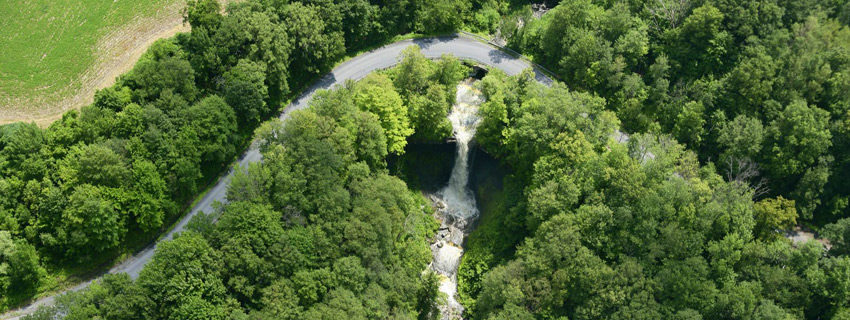
Photo: Bill Hecht
Save the South End of Skaneateles Lake
Success Story: Maintaining Public Access to Carpenter’s Falls
Through three separate acquisitions, the Finger Lakes Land Trust secured a mile-long corridor along Bear Swamp Creek – the largest tributary to Skaneateles Lake. Extending from the lake’s western shore to Carpenter’s Falls, this conservation corridor features a rugged gorge and a forest of towering hemlocks, maples, and cherries. Today, access to Carpenter’s Falls is owned and managed by the NYS Department of Environmental Conservation and lands downstream are held by the Land Trust. Through this partnership, visitors can hike on the trail connecting the falls to the lakeshore.
Enjoyed by generations of visitors, public access to Carpenter’s Falls was almost lost when the land was marketed as a “trophy” home site in 2008. While New York State wanted to protect the land, it was not able to move quickly enough. Fortunately, the Land Trust was able to purchase the land and then re-sell it to the state when funds became available. This same approach was used again recently when the Land Trust acquired a 140-acre addition to nearby Bear Swamp State Forest.
You Can Advance Conservation in the Finger Lakes Region
Contact the Finger Lakes Land Trust and see the main web page to learn more about regional conservation and how you can help.

